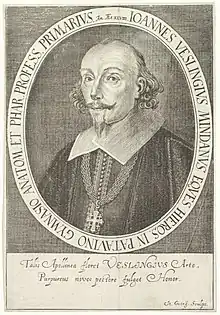
Johann Vesling (Latin: Veslingius) (1598 – 30 August 1649) was a German anatomist and botanist from Minden, Westphalia. He published a major illustrated work on human anatomy Syntagma Anatomicum (1641).
Life and work

Vesling was born in Minden, Westphalia. His Catholic family fled to Vienna to escape religious persecution. It is thought that he studied at the University of Leiden from 1619. He trained in botany and medicine but he received a degree from the University of Venice. In 1628 he was applied as an "Incisor" at the medical college in Venice. In the same year he traveled to Egypt and Jerusalem, where he was the personal physician of the Venice consul, and also conducted extensive studies of regional flora (particularly medicinal plants). In 1632 he became professor of anatomy and surgery at Padua, where he was an instructor to Thomas Bartholin. His popularity however was the cause of his downfall. Later in his career, he succeeded Prospero Alpini (died 1616) as director of the botanical garden at the University of Padua. He was made a physician to statesman Alvise Cornaro and accompanied Cornaro to Cairo in 1628. In Egypt he began to conduct botanical studies which led in 1640 to the publication of an annotated edition of De plantis Aegypti first published by Prospero Alpini in 1592, and a work on balsam published in 1644. Veslingius returned to Padua in 1633.[1][2]
Vesling is best remembered for the 1641 publication of Syntagma anatomicum, publicis dissectionibus, in auditorum usum, diligenter aptatum, a popular textbook based on his anatomical dissections in Padua. In this work he provided an early discussion of the human lymphatic system, and included the earliest sketches of the lacteals in humans.[3] Vesling also performed important studies of blood circulation, and was one of the first physicians to describe the brain's circle of Willis.[4]
Vesling's work influenced the Japanese physician Touyou Yamawaki (1705-1762)[5] and the English scientist John Evelyn.[6]
References
- ↑ Vesling, Johann (1644). Opobalsami veteribus cogniti vindiciae. Padua: typis Pauli Frambotti bibliopolae.
- ↑ Ghosh, Sanjib Kumar (2014). "Johann Vesling (1598-1649): Seventeenth century anatomist of Padua and his Syntagma Anatomicum: Vesling and Syntagma Anatomicum". Clinical Anatomy. 27 (8): 1122–1127. doi:10.1002/ca.22454. PMID 25125074. S2CID 11777547.
- ↑ Natale, Gianfranco; Bocci, Guido; Ribatti, Domenico (September 2017). "Scholars and scientists in the history of the lymphatic system". Journal of Anatomy. 231 (3): 417–429. doi:10.1111/joa.12644. ISSN 0021-8782. PMC 5554832. PMID 28614587.
- ↑ Dumitrescu, Ana Maria; Costea, Claudia Florida; Cucu, Andrei Ionuţ; Dumitrescu, Gabriela Florenţa; Turliuc, Mihaela Dana; Scripcariu, Dragoş Viorel (2021). "The discovery of the circle of Willis as a result of using the scientific method in anatomical dissection". Romanian Journal of Morphology and Embryology. 61 (3): 959–965. doi:10.47162/RJME.61.3.38. PMC 8112754. PMID 33817741.
- ↑ Izumi, Yoshio; Isozumi, Kazuo (2001). "Modern Japanese medical history and the European influence". The Keio Journal of Medicine. 50 (2): 91–99. doi:10.2302/kjm.50.91. PMID 11450598.
- ↑ Aspin, Richard K (1995). "Illustrations from the Wellcome Institute Library: John Evelyn's tables of veins and arteries: a rediscovered letter". Medical History. 39 (4): 493–499. doi:10.1017/S0025727300060397. ISSN 0025-7273. PMC 1037032. PMID 8558995.
External links
- De plantis aegyptiis (in Latin). Padova. Paolo Frambotto. 1638.
- Syntagma anatomicum (1647)
- Heirs of Hippocrates